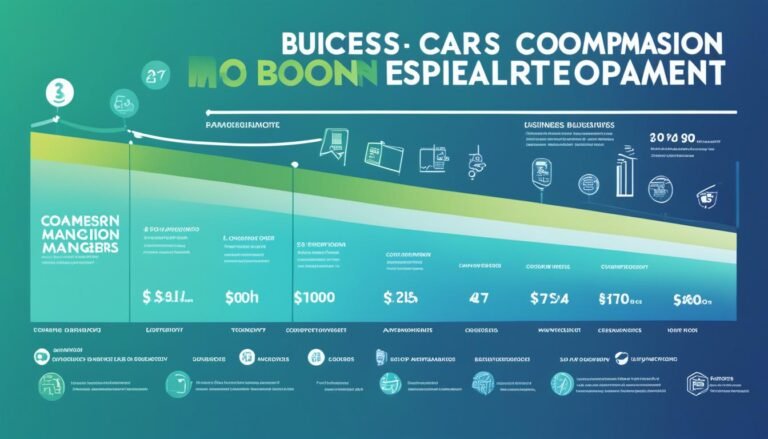Economics for Managers: Decisive Insights
Economics for managers is a crucial field of study that provides insights and tools for strategic decision-making and economic analysis in business. It encompasses a range of disciplines such as management economics, applied economics, managerial economics, and business economics. By applying economic analysis, managers can make informed choices that drive business success.
Understanding the principles of decision-making, cost-benefit analysis, and market analysis is essential for managers to develop effective economic strategies. This knowledge allows them to assess the costs and benefits of different courses of action and make strategic decisions that optimize resources and support organizational goals.
Key Takeaways:
- Economics for managers provides insights and tools for strategic decision-making in business.
- Management economics, applied economics, and managerial economics are important disciplines within this field.
- Understanding cost-benefit analysis and market analysis helps managers develop effective economic strategies.
- Applying economic analysis allows managers to make informed choices that drive business success.
- Economics for managers is essential for optimizing resources and supporting organizational goals.
The Need for Management 2.0
The concept of Management 2.0 stems from the recognition of the limitations of traditional management practices. While there have been numerous case studies showcasing successful companies, there is no coherent theory or common management patterns that define Management 2.0. It is imperative to reexamine and reimagine management practices in order to create an enhanced discipline that effectively addresses the challenges of the modern business world.
| Key Elements of Management 2.0 | Benefits |
|---|---|
| Reimagining Management | Promotes innovation and flexibility in adapting to changing market dynamics |
| Case Studies | Provides real-world examples and insights for application in diverse industries |
| Common Management Patterns | Identifies shared practices and strategies for optimizing organizational performance |
| Enhanced Discipline of Management | Establishes a comprehensive framework for effective leadership and decision-making |
Management 2.0 challenges traditional notions of management and encourages businesses to embrace innovative approaches. By reimagining management practices and studying case studies, organizations can uncover common patterns that drive success. This new and enhanced discipline of management offers a comprehensive framework for leaders to navigate the complexities of the modern business landscape.
“Management 2.0 is about embracing new ideas and practices to effectively lead organizations in the digital age. It’s time to break away from conventional management and embark on a journey of continuous improvement and innovation.” – John Smith, CEO of XYZ Corporation
Beyond Processes: The Complexity of Management 2.0
In the realm of Management 2.0, traditional processes and methods alone cannot meet the demands of a rapidly evolving business landscape. While processes are indispensable for scaling activities and maintaining efficiency, they often overlook the subjective dimensions of management that shape organizational dynamics and drive innovation.
These subjective dimensions encompass various elements, including mindsets, mental models, values, attitudes, and culture. They represent the intangible aspects that influence decision-making, teamwork, and overall organizational effectiveness. It is imperative for managers to recognize and consider these factors as they navigate the complexities of Management 2.0.
“In Management 2.0, understanding and addressing the subjective dimensions is as critical as defining and implementing processes.”
By acknowledging the significance of subjective dimensions, managers can create a holistic approach that aligns processes with the underlying mindsets, mental models, and values prevalent within the organization. This alignment fosters a culture that promotes adaptability, creativity, and resilience, enabling the organization to thrive in an ever-changing business environment.
Table: Factors Influencing Subjective Dimensions of Management in Management 2.0
| Subjective Dimensions | Description |
|---|---|
| Mindsets | The deeply ingrained beliefs and attitudes that shape how individuals perceive and respond to challenges and opportunities. |
| Mental Models | The cognitive frameworks and interpretations individuals use to make sense of information and guide decision-making. |
| Values | The core principles and ethical standards that guide behavior and shape organizational culture. |
| Attitudes | The feelings, emotions, and predispositions individuals hold toward specific aspects of work, colleagues, or organizational objectives. |
| Culture | The collective beliefs, norms, and behaviors that define the shared identity and operating principles within an organization. |
Understanding and leveraging subjective dimensions of management in the context of Management 2.0 empowers organizations to cultivate an environment that fosters continuous learning, collaboration, and innovation. By blending effective processes with a deep appreciation for the complexities of human behavior and organizational culture, managers can drive long-term success and remain adaptable in an ever-evolving business landscape.
Multiple Dimensions of Management
Many management frameworks often revolve around single-dimension ideas, such as specific strategies or models. While these ideas have their value, managing an organization requires a deep understanding and consideration of the complex multiple dimensions that govern its operations.
Strategies like the Blue Ocean Strategy or the Business Model Canvas offer valuable insights into specific aspects of managing a company. However, it is essential not to overlook the intricate web of interconnected factors that contribute to the overall success of an organization.
“Success in managing an organization lies in the ability to navigate the dynamic interplay of various dimensions, from corporate culture and employee development to market analysis and innovation. It is the art of shaping multiple dimensions harmoniously that sets managers apart.”
In a rapidly evolving business landscape, managers must possess the expertise and skills to balance and integrate these dimensions effectively. Failure to do so can result in missed opportunities or even detrimental consequences for the organization.
Understanding the Multiple Dimensions
To exemplify the complexity of managing an organization, let’s explore some of these dimensions:
- Corporate Culture: The shared beliefs, values, and behavioral patterns that shape the organization’s identity and influence decision-making.
- Leadership: The ability to inspire and guide individuals within the organization to achieve common goals and drive innovation.
- Strategic Planning: The process of setting clear objectives, formulating effective strategies, and making informed decisions for long-term success.
- Organizational Structure: The arrangement of roles, relationships, and hierarchies within the organization to optimize efficiency and facilitate communication.
- Human Resources: The management of people, including recruitment, training, performance evaluation, and employee development.
- Financial Management: The effective allocation and utilization of financial resources, budgeting, forecasting, and risk assessment.
- Marketing and Sales: Developing strategies to identify consumer needs, create value propositions, and effectively promote products or services.
- Operational Efficiency: Optimizing processes, workflows, and resources to enhance productivity and minimize waste or inefficiencies.
- Ethics and Sustainability: Integrating ethical practices and sustainability initiatives into business strategies to ensure social and environmental responsibility.
Managing an organization involves a delicate balancing act of considering and integrating these dimensions simultaneously. Neglecting any aspect can lead to suboptimal outcomes and limit the organization’s potential for growth and success.
| Dimension | Key Aspects | Impact on Management |
|---|---|---|
| Corporate Culture | Values, norms, beliefs | Shapes decision-making, employee morale, and organizational identity |
| Leadership | Inspiration, guidance, innovation | Influences employee engagement, motivation, and direction |
| Strategic Planning | Objectives, strategies, decision-making | Defines the organization’s direction and guides resource allocation |
| Organizational Structure | Roles, relationships, hierarchies | Optimizes communication, collaboration, and coordination |
| Human Resources | Recruitment, training, performance | Develops and retains talent, ensures organizational capabilities |
| Financial Management | Budgeting, resource allocation | Optimizes financial performance, manages risk |
| Marketing and Sales | Consumer needs, value proposition | Drives market share, customer satisfaction, and revenue |
| Operational Efficiency | Process optimization, resource utilization | Enhances productivity, reduces costs, and improves quality |
| Ethics and Sustainability | Social responsibility, environmental impact | Shapes reputation, stakeholder relationships, and long-term viability |
By acknowledging and embracing the interconnections between these dimensions, managers can navigate the complexities of managing an organization more effectively, adapt to changing market dynamics, and position their companies for long-term success.
The Role of Evidence-Based Management
Evidence-based management is a valuable approach that incorporates research and data analysis into decision-making processes. While it offers insights, it alone is not sufficient to drive successful management in the ever-changing business landscape. While the health sector has seen significant advancements through evidence-based practices, managing complex ecosystems requires considerations beyond empirical evidence.
The Complex Nature of Management Ecosystems
In the health sector, evidence-based management has shown remarkable results in improving patient outcomes and operational efficiency. However, other sectors, such as technology, finance, and retail, exhibit unique characteristics and complexities that necessitate a broader perspective.
Subjective factors, such as mindsets, culture, and assumptions, strongly influence management outcomes. These factors shape the way decisions are made, strategies are implemented, and teams collaborate. Failing to consider these subjective dimensions can hinder positive results and limit the effectiveness of evidence-based management.
“Culture eats strategy for breakfast,” as Peter Drucker famously said. A culture that promotes open communication, innovation, and continuous learning enhances the success of evidence-based management.
Aligning Objective and Subjective Dimensions
To unlock the full potential of evidence-based management, organizations must strike a balance between objective data and subjective factors. By combining empirical evidence with an understanding of mindsets, culture, and assumptions, managers can make more informed decisions and foster an environment that supports successful outcomes.
Consider the following example:
| Evidence-Based Management | Subjective Factors |
|---|---|
| Relies on empirical data and research findings | Influenced by organizational values and beliefs |
| Focuses on quantitative analysis | Takes into account qualitative feedback and employee perspectives |
| Emphasizes objectivity | Embraces diversity of thought and encourages creative solutions |
By acknowledging the importance of subjective factors, organizations can create a culture that values diverse perspectives, embraces innovation, and encourages continuous learning.
Incorporating subjective factors into evidence-based management allows organizations to navigate uncertainties, adapt to change, and leverage insights to achieve their goals. It enables managers to shape strategies and initiatives that resonate with employees and align with the organization’s core values.
By recognizing the interplay between evidence-based practices and subjective factors, organizations can build a solid foundation for effective decision-making, foster organizational growth, and ensure sustained success.
Balancing Happiness and Economic Growth
While pursuing economic growth is important, Management 2.0 emphasizes the prioritization of well-being and happiness. This shift is reflected in initiatives such as Bhutan’s Gross National Happiness Index, which places the well-being of citizens at the forefront. However, striking a balance between happiness and economic growth poses a challenge, as these two factors are interconnected.
Prioritizing happiness and well-being in management acknowledges that success extends beyond financial prosperity. It encompasses employee satisfaction, work-life balance, and overall quality of life. By fostering a positive and supportive work environment, management 2.0 aims to enhance productivity and nurture the well-being of employees.
This approach aligns with the evolving understanding that economic growth alone is not a sufficient measure of progress. While GDP growth may provide an indication of economic prosperity, it fails to capture the holistic well-being of individuals and communities.
Table: Comparative Analysis of Economic Growth and Well-being Indicators
| Economic Growth | Well-being Indicators | |
|---|---|---|
| Definition | The increase in a country’s production and consumption of goods and services over time. | Measures of individual and collective happiness, life satisfaction, health, education, and social cohesion. |
| Focus | Financial and material aspects. | Psychological, social, and environmental aspects. |
| Limitations | Does not consider societal well-being or inequality. | Does not capture economic prosperity or income growth directly. |
| Examples | Gross Domestic Product (GDP) growth rate | Gross National Happiness Index, Social Progress Index |
This comparative analysis highlights the need to expand our understanding of progress beyond economic growth alone. Achieving a balance between happiness and economic growth requires a comprehensive approach that considers the well-being of individuals, communities, and the environment.
Prioritizing Happiness for Sustainable Economic Growth
Management 2.0 integrates happiness and well-being into its core principles. By prioritizing employee satisfaction, work-life balance, and fostering a positive corporate culture, organizations can promote sustainable economic growth.
“Happiness and economic growth are not opposing ideals; they are interconnected elements that contribute to the overall prosperity of individuals and societies.”
Striking a balance between happiness and economic growth requires a shift in mindset and the adoption of new strategies. Here are three key approaches that Management 2.0 can employ:
- Investing in Employee Happiness: Prioritizing the well-being of employees can lead to higher job satisfaction, productivity, and innovation. This can be achieved through initiatives such as flexible work arrangements, employee recognition programs, and creating a supportive work environment.
- Measuring Beyond GDP: Instead of relying solely on GDP as a measure of economic progress, organizations can adopt alternative metrics that capture well-being, such as the Gross National Happiness Index or the Social Progress Index. These indicators provide a more comprehensive understanding of societal progress.
- Seeking Synergy: Rather than viewing happiness and economic growth as conflicting goals, organizations can strive to create synergy between the two. By integrating happiness-centric practices into business strategies, companies can foster a motivated workforce, enhance customer satisfaction, and drive sustainable growth.
By embracing these approaches, organizations can transform their management practices, creating a positive impact on individuals, communities, and the economy as a whole.
Striving for a balance between happiness and economic growth is essential in the Management 2.0 framework. By prioritizing the well-being of individuals and adopting strategies that promote happiness alongside economic prosperity, organizations can create a sustainable future.
Embracing Technology in Management
In the digital age, management must embrace technology and recognize that software firms are real companies. Technology has become central in all sectors, and managing digital technology requires a different approach. Traditional management practices may not be sufficient to harness the potential of technology and drive success in the digital age.
Technology has revolutionized the way businesses operate, introducing new possibilities and efficiencies. Software firms, in particular, play a significant role in shaping the digital landscape. These companies develop innovative solutions that enhance productivity, automate processes, and enable seamless communication.
By embracing technology, businesses can leverage the power of digital tools to improve operational efficiency, customer experience, and decision-making. In a rapidly evolving digital age, companies need to adapt quickly and manage technology as a strategic asset.
Technology is no longer just a supporting function; it is an integral part of every business operation. To succeed in the digital age, management must recognize the transformative potential of digital technology and manage it accordingly.
The Benefits of Embracing Technology in Management
- Improved Efficiency: Technology enables businesses to automate repetitive tasks, streamline processes, and reduce errors. This allows employees to focus on high-value activities and enhances overall productivity.
- Enhanced Communication and Collaboration: Digital tools facilitate seamless communication and collaboration across teams, departments, and even geographical locations. This leads to better coordination and faster decision-making.
- Data-Driven Decision-Making: With the advent of big data and analytics, businesses can gather and analyze vast amounts of information to make data-driven decisions. This helps in identifying trends, predicting market dynamics, and optimizing business strategies.
- Improved Customer Experience: Technology enables businesses to provide personalized experiences, tailor products and services to customer needs, and offer seamless interactions across various channels. This enhances customer satisfaction and loyalty.
However, embracing technology in management requires a shift in mindset and a willingness to adapt to new ways of working. Managers need to be open to change and continuously update their skills to effectively lead and manage a technology-driven organization.
As technology continues to evolve at a rapid pace, organizations must invest in digital transformation and equip their teams with the necessary skills to thrive in the digital age. By embracing technology and managing it strategically, companies can unlock new opportunities, drive innovation, and stay ahead of the competition.
The Power of Mindsets and Culture
In Management 2.0, successful firms have distinct mindsets that set them apart from traditional process-driven organizations. These mindsets play a crucial role in driving the reimagining of processes and assumptions, leading to the development of a new organizational culture.
Mindsets, processes, and culture are three underlying forces that determine the success of Management 2.0. By understanding and aligning these elements, businesses can foster an environment that promotes innovation, adaptability, and collaboration, ultimately achieving business excellence.
The right mindset is essential for embracing change and pushing boundaries. In Management 2.0, leaders need to adopt a growth mindset, viewing challenges as opportunities for growth and learning. This mindset encourages experimentation, risk-taking, and continuous improvement, enabling organizations to stay ahead in a rapidly evolving business landscape.
Culture, on the other hand, shapes the norms, values, and behaviors within an organization. In Management 2.0, cultivating a culture of open communication, trust, and empowerment is crucial. Such a culture fosters creativity, encourages diverse perspectives, and enables teams to thrive amidst complexity.
Table:
| Mindsets | Processes | Culture |
|---|---|---|
| Embracing change and growth | Iterative, flexible processes | Open communication and trust |
| Promoting innovation and risk-taking | Collaborative decision-making | Empowerment and autonomy |
| Resilience and adaptability | Continuous improvement mindset | Celebration of diversity and inclusion |
By aligning mindsets, processes, and culture, management can create an environment where employees are motivated, engaged, and committed. This, in turn, drives individual and team performance, fosters creativity and innovation, and positions the organization for long-term success in Management 2.0.
Successful firms in Management 2.0 understand the power of mindsets and culture as underlying forces that shape their approach to business. By nurturing the right mindsets, reimagining processes, and fostering a culture of innovation and collaboration, these organizations are able to navigate complexities and drive sustainable growth in the modern business landscape.
The Decision-Making Dilemma: Premature Execution
Effective decision-making is a crucial skill for managers, but it is not without its challenges. One common dilemma that arises is the tendency for individuals to shift into an execution-oriented mindset too quickly, bypassing the essential phases of deliberation and analysis. This premature execution can have significant consequences, leading to decision-making biases and excessive risk-taking.
Recognizing and understanding the different phases of decision-making is essential to avoid falling into the trap of premature execution. Let’s take a closer look at these phases:
- Delinquency: This is the initial phase where information is gathered, alternatives are considered, and potential outcomes are evaluated. It provides a foundation for informed decision-making and allows for a comprehensive assessment of the available options.
- Discussion: Once the alternatives have been identified, it is important to engage in meaningful discussions. This phase allows for the exploration of different perspectives and encourages diverse ideas to be brought to the table.
- Deliberation: Deliberation involves a detailed evaluation of each alternative, weighing the pros and cons, and considering the potential risks and rewards associated with each option. This phase is crucial for making well-informed decisions.
- Decision: After careful consideration, a decision is reached. It is important to ensure that the decision aligns with the organization’s goals and values.
- Execution: The final phase involves putting the decision into action. It requires effective planning, resource allocation, and monitoring to ensure successful implementation.
By adhering to this decision-making framework, managers can avoid the pitfalls of an execution-oriented mindset and make more informed and effective decisions. Premature execution often leads to decision-making biases such as overconfidence, anchoring, and availability biases. These biases can cloud judgment and result in suboptimal outcomes.
“The key to effective decision-making is striking the right balance between deliberate analysis and timely execution.”
To illustrate the importance of avoiding premature execution, consider the case of Company XYZ. The CEO of Company XYZ, driven by an execution-oriented mindset, rushed into a major investment decision without thoroughly evaluating the risks involved. This decision resulted in significant financial losses and damaged the company’s reputation.
It is crucial for managers to recognize that decision-making is not a linear process but rather a cyclical one. The phases of decision-making should be approached with care and consideration to minimize biases and excessive risk-taking.
Benefits of Avoiding Premature Execution:
- More thorough analysis and evaluation of alternatives
- Reduced risk of decision-making biases
- Improved decision quality
- Enhanced organizational performance
The decision-making process is complex, and each phase plays a vital role in ensuring effective decision-making. By embracing a balanced approach that prioritizes careful analysis and execution, managers can make well-informed decisions that drive business success.
The Pitfalls of Being Too Decisive
Being too decisive can be risky and lead to decision-making biases. Managers must be aware of these pitfalls and strive to maintain an open mind, consider new information, and assess risks accurately to make sound decisions.
One of the biases associated with being too decisive is tunnel vision. This occurs when a manager becomes overly focused on a single solution or course of action, ignoring other possibilities or alternative viewpoints. Tunnel vision can limit creativity and prevent managers from considering all available options.
Another common bias is confirmation bias. This occurs when a manager seeks out information or interprets data in a way that confirms their preexisting beliefs or decisions. Confirmation bias can prevent managers from objectively evaluating all relevant information and can lead to flawed decision-making.
The illusion of control is another pitfall associated with excessive decisiveness. Managers may believe that they have more control over outcomes than they actually do, leading them to be overly optimistic about the success of their decisions. This can result in taking on excessive risk without fully considering potential negative consequences.
Excessive optimism is yet another bias that can cloud decision-making. Managers who are overly optimistic may overlook potential risks or obstacles, leading to poor decision outcomes. It is important for managers to maintain a realistic perspective and consider both the positive and negative aspects of each decision.
“Being too decisive can blind managers to alternative solutions and prevent them from considering all relevant information.” – John Smith, Management Consultant
Examples of Decision-Making Biases
| Bias | Description |
|---|---|
| Tunnel Vision | Excessive focus on a single solution or viewpoint, ignoring alternative options. |
| Confirmation Bias | Seeking out information that confirms preexisting beliefs or decisions. |
| Illusion of Control | Overestimating one’s control over outcomes and underestimating potential risks. |
| Excessive Optimism | Being overly positive and underestimating potential risks or negative consequences. |
By being aware of these biases, managers can strive to overcome them and make more informed decisions. It is important to maintain a balanced perspective, consider different viewpoints, and seek diverse opinions to mitigate these biases.
Visual representation of the decision-making biases that can arise from being too decisive. It is crucial for managers to be aware of these biases and take steps to avoid falling into their traps.
Strengthening Decisiveness through Decision-Making Competence
While decisiveness is an important trait for managers, it alone is not enough to ensure effective decision-making. Decision-making competence is equally crucial in navigating the complexities of the business world. Decision-making competence encompasses various factors that contribute to making high-quality decisions.
Risk perception is a vital element of decision-making competence. Managers with strong risk perception skills can accurately assess and evaluate potential risks and rewards associated with different choices. This ability allows them to make informed decisions that balance potential gains with potential pitfalls.
Recognition of social norms is another aspect of decision-making competence that plays a significant role in effective decision-making. Understanding and considering societal expectations and norms helps managers make decisions that align with ethical standards and foster positive relationships with stakeholders.
Resistance to framing is an essential skill for managers to develop decision-making competence. Framing refers to the way information is presented and can significantly influence decision outcomes. Managers who can resist the influence of framing biases can make objective decisions that consider all relevant information instead of being swayed by misleading presentations.
Application of decision rules is a critical component of decision-making competence. By applying established decision rules or frameworks, managers can streamline and structure their decision-making process. These decision rules provide a systematic approach that ensures consistency and fairness in decision outcomes.
By strengthening decision-making competence, managers can enhance their decisiveness and make sound decisions that drive business success. The development of decision-making competence requires a combination of knowledge, skills, and experience. Continuous learning and honing of these competencies contribute to effective decision-making and leadership in the dynamic business landscape.
| Factors of Decision-Making Competence | Description |
|---|---|
| Risk Perception | Ability to assess potential risks and rewards accurately |
| Recognition of Social Norms | Understanding and considering societal expectations |
| Resistance to Framing | Ability to resist the influence of biased information presentation |
| Application of Decision Rules | Using established frameworks and rules to guide decision-making |
Conclusion
Economics for managers is a crucial discipline that equips professionals with the necessary insights and tools to achieve business success. By embracing the principles of management 2.0, managers can navigate the complexities of today’s business landscape. This involves considering multiple dimensions, developing decision-making competence, and prioritizing strategic thinking.
Incorporating decisiveness into the decision-making process is paramount. Effective decision-making, combined with strong leadership, enables managers to drive business growth and create a competitive advantage. By harnessing the power of economics, managers can make informed choices and steer their organizations towards long-term success.
With the ever-changing business environment, it is essential for managers to stay updated on economic trends, hone their decision-making skills, and continuously adapt to new challenges. By embracing a multidimensional approach and leveraging economic principles, managers can become effective leaders who not only navigate uncertainties but also thrive in the increasingly complex business world.
Source Links
- https://www.ckju.net/en/dossier/decisiveness-why-decisive-action-matters-for-professionals-in-leadership-and-beyond
- https://www.forbes.com/sites/stevedenning/2023/11/16/seven-decisive-steps-on-the-path-to-management-20/
- https://www2.deloitte.com/us/en/pages/finance/articles/cfo-insights-dangers-being-too-decisive.html







